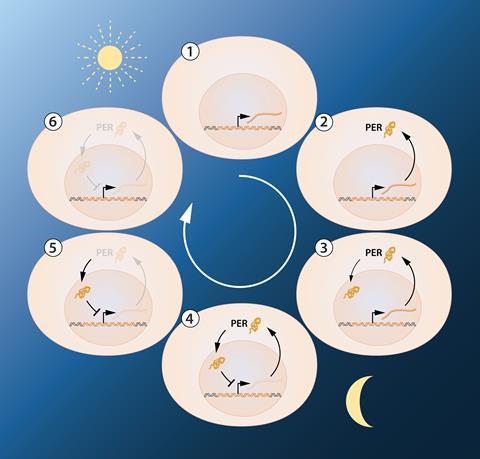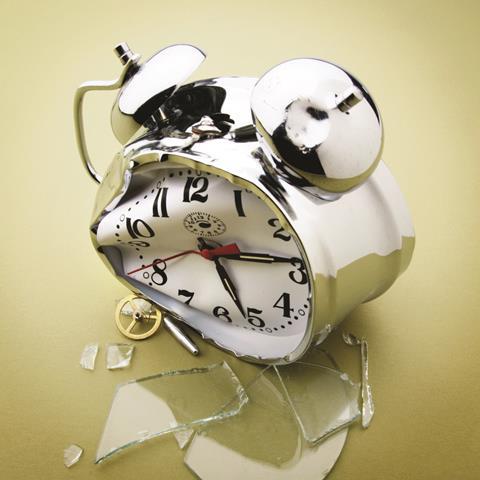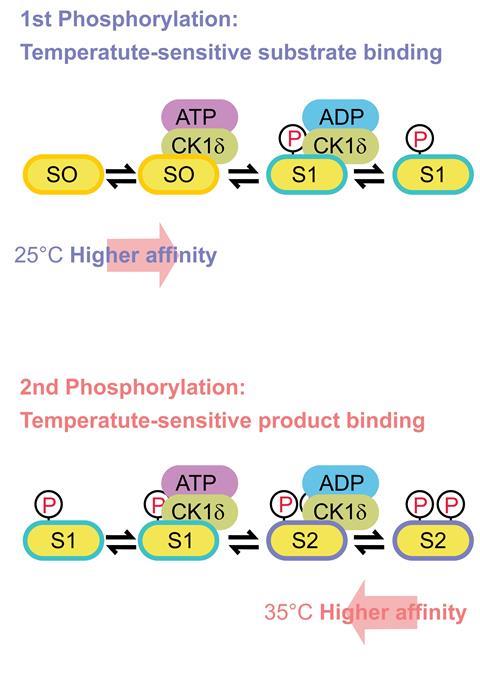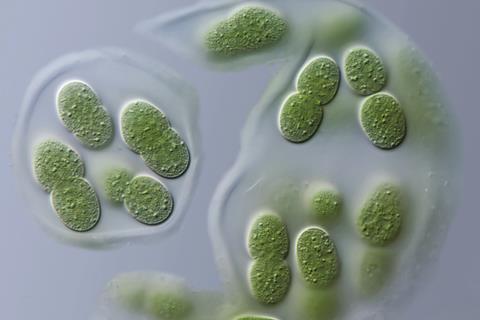Almost every cell of every organism has its own little clock, but what makes it tick? Fiona Case finds out

Life on Earth evolved on a rotating sphere orbiting a star, and organisms – from the earliest cyanobacteria and plants to mankind – have to cope with the daily variation of light and temperature from day to night. In eukaryotic organisms, this daily cycle is reflected in the nucleus of almost every cell. An oscillating pattern of protein production and disintegration maintains a (roughly) 24 hour pulse – the ticking of a molecular clock. In humans and other diurnal species, as day approaches proteins are created to warm us and lower the threshold for arousal; to wake us up and to get us ready for food and activity. The proteins produced at night provide a cooler, although still physiologically active, sleep. And then the cycle begins again.
The sequence of bases in the DNA polymer, tightly packed in the nucleus the cell, encodes the sequence for the vast majority of proteins that will ever by created by the organism. Which molecule will be made is determined by protein-based catalysts, the transcription factors, which bind to specific parts of the DNA and allow RNA polymerase to create a transcript of the sequence. This messenger RNA (mRNA) is transported out of the nucleus and directs protein synthesis in the cytoplasm. But how does the cell know which transcription factors to use when, and how is the production of proteins orchestrated through the day and night?
In 1971 Seymour Benzer, a professor at the California Institute of Technology in the US, and his graduate student Ronald Konopka exposed fruit flies to ethyl methylsulfonate to create errors in their DNA. They created mutants that behaved as if they had evolved on different planets, worlds with rotation periods of 19 or 27 hours, or with no intrinsic light and dark cycle. Remarkably they were able to show that a single gene, a specific piece of DNA, was responsible for this change. This was the first time behaviour (rather than physical characteristics, such as eye colour or wing shape) had been linked to a gene, but the importance of this work was not immediately appreciated. As Michael Rosbash, of Brandeis University in Massachusetts, US, pointed out in his acceptance speech for the 2017 Nobel prize in physiology or medicine, Benzer and Konopka’s seminal paper only received nine citations over the next decade.
How does the cell know which transcription factors to use when
It was not until the development of technologies such as recombinant DNA and DNA sequencing that this gene, called period or per, and the PER protein it specified could be characterised and its role in the circadian system could start to be elucidated.
‘In 1990 Paul Hardin produced what is arguably the most important paper from my lab which showed that the PER protein was involved in a feedback loop which regulated the oscillations of its own mRNA,’ explains Rosbash. ‘If you repeat the experiment in a modified fly in which the period protein has a one amino acid difference from the wild type protein, then the difference in the peak concentration of mRNA is 19 or 20 hours rather than 24 hours, exactly mimicking the behavior of the modified fly.’
This early paper didn’t mention transcription – the researchers thought that the PER protein might be interacting with the mRNA in the cytoplasm where it was synthesised. Follow-up work established that PER was going into the nucleus of cells, and identified the protein transcription factors it turned off in the nucleus – including the CLOCK and BMAL transcription factors in mammals, and the CLOCK and CYCLE transcription factors in fruit flies.

An outline of the clock mechanism emerged. Over several hours, starting in the early hours of the morning, the PER protein is synthesised and begins to accumulate in cytoplasm. As its concentration increases, it starts to be transported into the nucleus, peaking in the middle of the night. In the nucleus it binds and deactivates its own transcriptional factors, stopping production of its own mRNA, and turning off further production. Over the next few hours, the PER protein in the nucleus is degraded and removed, until the mRNA starts to be exported again to ramp up PER production for another day.
This negative feedback loop is at the heart of a circadian control system of almost Byzantine complexity, with interconnected transcription and feedback loops that govern rhythmic production of 10–20% of all proteins in cells throughout organisms from mammals to plants and insects.
Regulating chemistry
The external manifestations of the circadian rhythm are obvious – we sleep and wake, maintain or lose our concentration, change our body temperature and use the bathroom on a regular schedule. And the social and evolutionary benefits of this rhythmic behavior are clear. Being synchronised with the planet’s rotation allows diurnal organisms such as humans make the best use of daylight hours and to constrain cell repairs and memory adjustments to the night-time. This synchronisation helps us live in groups, with everyone doing the same things at the same time. But one of the earliest and most important benefits of a circadian system was to regulate chemistry.
‘The compartmentalisation of the cell was a critical step in evolution – the creation of different areas, which could be doing different chemistries, separated by membranes through which reactants and products could pass,’ explains Russell Foster, professor of circadian neuroscience at the University of Oxford in the UK. ‘The development of temporal separation was equally important. Different steps in metabolism, for example oxidative and reductive reactions, must be scheduled to occur at different times.’
Concentrations of metabolic hormones like glucagon and insulin vary through the day in anticipation of eating. Intrinsic day/night differences in redox state in heart cells affect cardiac excitability via modulation of ion channels, and may generate the changes in brain states that allow us to establish memories at night.
Failure of the clock

Links are emerging between the circadian system and disease in humans. People with a later chromotype – whose internal clocks are set to run late show poorer glycemic control, and have higher rates of cardiovascular disease Mutations in the gene that encodes for the melanopsin photopigment can lead to clinical disorders, such as seasonal affective disorder (SAD).
‘When we look at patients with certain kinds of mental illness we see that the natural rhythm is not just distorted, it is really smashed,’ says Foster. Even a basic resetting of time for these patients can be useful. ‘Studies involving schizophrenia sufferers showed that psychotic episodes were reduced by around 50% with the forced regulation of sleep,’ he notes. ‘I’m also excited about the potential for early diagnostics and for reducing the severity of symptoms – for example, in children at risk for biopolar disorders. A breakdown in their circadian rhythm is a harbinger that can prompt early intervention, and if you correct the wake/sleep cycle you could delay the onset of the disease.’
Sometimes the internal clock mechanism is running correctly – physiological changes occur on a 24 hour cycle – but the clock is set to the wrong time of day. The response to the mismatch can causes illness. ‘People adopt unconscious strategies to override the signals that are causing them to feel sleepy or wide awake at the wrong time. They compensate by activating the stress axis,’ says Foster. ‘This leads to higher levels of cortisol, increased blood pressure – powerful physiological changes that can cause damage or worsen disease.’
Disease progression was far faster in mice with cancer that were exposed to periods of light and dark out of synchronisation with their internal clocks than for those that were living on a natural schedule. These results have clear implications for shift workers, and for people with heavy international travel schedules.
Our increasing understanding of the molecular basis for circadian rhythms is providing insights into drug metabolism. The efficacy of some drugs appears to vary depending on when they are administered. It has also provided new targets for drug development. Foster’s group is going into phase III trials with a molecule that may help re-set the circadian clock for patients who have lost their eyes through injury. They hope their drug will prompt the increase the levels of calcium and cAMP in the SNC which would usually result from light stimulation of the photosensitive ganglion cells.
Light control
In 1998, Ueli Schibler led a team at the University of Geneva in Switzerland that discovered that mouse fibroblast cells that had been frozen for 25 years were still capable of expressing strong circadian rhythms – well away from any signalling that could have come from other parts of the mouse. It soon became apparent that a clock mechanism exists in almost all cells. The beat of these myriad clocks is kept in alignment by controlled pulses from a group of around 20,000 neurons in the suprachiasmatic nuclei (SCN) – a tiny region of the brain situated close to the optic nerve fibers.
It was Foster who first used the orchestra analogy: ‘The SCN is the conductor keeping the various instruments playing at the same pace as they read the music of life from the DNA score. If you shoot the conductor everything happens at the same time. You have a cacophony rather than a symphony’
But this clock can change. To align with the seasonal change of length of day and night, animals must readjust their intrinsic clocks to the new cycle. International travellers do – eventually – manage to readjust to their new time zone.
This is a challenge for teenagers who often experience light late into the evening, but rarely see the sunrise!
Light is the most important environmental time cue for resetting, or entraining, the circadian clock. Without the normal daily cycle of light and dark, the clock starts to drift. Rhythms persist, but they deviate from the 24 hour cycle. Various ‘bunker’ experiments, in which volunteers live in time-free environments with constant light and temperature and an irregular supply of meals, have shown that over time they start to live on a longer schedule. Without the daily synchronising cue, most of us will get up later and later.
Research in the Foster lab shows that the timing of the light is critical. ‘In early night, a light pulse signals an extended day; the phase of the SCN clock delays to adapt to this change. But, in late night, premature light signals an early day; the clock responds by advancing its phase,’ explains Foster. ‘This is a challenge for teenagers who often experience light late into the evening, but rarely see the sunrise!’
It was initially assumed that the signals that entrained the SCN in mammals came from the rod and cone photoreceptors in the eyes. But studies in the late 1990s showed that mice lacking all their rod and cone photoreceptors could still synchronise their circadian rhythms to light levels perfectly normally. ‘When the eyes were covered the ability to entrain was lost, so there had to be another photoreceptor within the eye,’ says Foster.
This is why we get jet lag: the clock cannot move immediately to a new dawn–dusk cycle
Ganglion cells receive information from the photoreceptive cells in the eye – the rods and cones – and send signals to the brain to be interpreted as visual information. But some of these ganglion cells (1–2%) are photosensitive themselves. They contain a photopigment, the melanopsin protein, which responds directly to differences in light and dark and sends this information to the SCN. This was the missing receptor.
‘When light of the correct wavelength hits the melanopsin photopigment, it triggers a sequence of signalling events that increase the levels of calcium (Ca2+) and 3’,5’-cyclic adenosine monophosphate (cAMP) within an SCN neuron,’ explains Foster. ‘This activates protein transcription factors which increase the production of the PER protein mRNA, and thus increase levels of PER.’
But all the mechanisms that balance the amount of PER in the cell are still in operation, so the enhancement doesn’t last long. ‘This is why we get jet lag: the clock cannot move immediately to a new dawn–dusk cycle because there is a brake on the effects of light on the clock,’ says Foster.
Temperature mystery
Another striking feature of the 24 hour oscillation of metabolic processes is the fact that the beat goes on, unperturbed, as temperature changes.
A clock that enables flowers to open in anticipation of the sunlight would be useless if it slowed down when the temperature dropped. Even in warm-blooded animals there is a temperature gradient between the skin and the core of the body. If the timing of metabolic processes within cells depended on where they were – and what the weather was like outside – it would be chaos.

This temperature-independence was a major stumbling block to early acceptance of an internal clock mechanism (rather than timing based purely on external cues such as day/night). Biological reactions obey the Arrhenius relationship as surely as any other chemical process and until recently no-one could provide a convincing reason why the clock didn’t speed up when it got warmer.
Recent work by Hiroki Ueda at the University of Tokyo in Japan reveals part of the answer: since the PER protein is required to inhibit the production of clock proteins – turning daytime activities into night-time rest – reducing the amount of PER will delay the clock. Most of the proteins in a cell have a short lifetime. Once they have completed their tasks, become unstable or unfolded, they are recycled. The trick to providing a sensitive counterbalance to thermal change is to destabilise exactly the right amount of PER.
To understand this exquisitely balanced chemistry we must introduce another family of players – the casein kinase 1 enzymes. As part of the circadian clock, casein kinase 1 transfers phosphate groups from adenosine triphosphate (ATP) to PER. The added charge on PER makes the protein unstable and it becomes a target for ubiquitination and disposal.
‘We have shown that there are two different mechanisms at work slowing the phosphorylation of the PER protein as temperature increases,’ says Ueda. ‘The affinity of the reactant enzyme–ATP complex to a substrate such as PER is reduced at higher temperatures. Molecular dynamics suggest that this is the result of large shape fluctuations in the catalyst slowing the binding.’ The brakes are also applied at the other side of the reaction equation. ‘The affinity of the product enzyme–ADP complex is increased,’ he explains. ‘These two mechanisms, acting at different sites, contribute to temperature compensation of the phosphorylation of PER proteins – and to maintaining the accuracy of the clock’
It is remarkable that the complex yet robust phenomenon of temperature compensation is regulated by a few phosphate groups and simple changes in electrostatic charge.
Clockwork molecules
The circadian system is ultimately a chemical phenomenon – and some of the most exciting current work is aimed at understanding the molecular scale behavior that is the clockwork mechanism. A good place to start is with a simpler clock.

Circadian rhythms started as a response to light. 500 million years ago, cyanobacteria evolved a simple molecular clock that enables the single cell organism to anticipate dawn and protect its DNA from damaging UV light. The cyanobacteria measures times using just three mutually associating proteins, KaiA, KaiB, and KaiC. Their self-assembly changes as the KaiC protein is phosphorylated during the day and de-phosphrylated at night. This changes the activity of transcription factors, and the smorgasbord of proteins that are selected to be made by the cell. But what measures the time – what makes this process take 24 hours?
Recent work by Andy LiWang at the University of California Merced in the US and Carrie Partch at the University of California, Santa Cruz, is revealing some of the molecular dynamics that control this clock. ‘Hydrogen–deuterium exchange mass spectrometry revealed that the KaiB protein undergoes a slow refolding from an inactive to an active state,’ says Partch. ‘We were able to crystallise a version of the protein which was “locked” into the transient active state, allowing us to see how the three proteins interact with one another in their night time states. This is important because it highlighted how different proteins compete for the same interfaces.’ This competitive binding, along with the slow refolding of KaiB and the dynamic switching of KaiA, allows the clock to measure the time between sunset and sunrise again and again.
The static part gets you to the right place on DNA, but the exciting parts are in the dynamic regions
Partch has been looking at other proteins involved in circadian systems – and finding more instances where protein dynamics contributes to the clock timing. ‘When people are trying to crystalise a protein they often clip off the disordered regions – but all the fun is in the dynamic part of the protein,’ she says. ‘If you analyze the difference between two very similar variants of the BMAL protein – one that works in the circadian clock (BMAL1) and another that doesn’t (BMAL2) – and you swap pieces of the two, you discover which regions are required for clock behaviour. There’s something special about a few key regions in the disordered tail of BMAL1 that plays an important role in timing.’
The model that is emerging is of a protein with a static part – the framework which contains structures that allow CLOCK to find and bind with BMAL, and which recognise and bind to the DNA – and more flexible regions that contribute to the timing of the clock. ‘The static part gets you to the right place on DNA to start transcription of a particular gene, but the exciting parts – where you get control – are in the dynamic regions,’ says Partch. Perhaps unsurprisingly the PER protein, which plays such a major role in circadian timing, is mostly disordered. ‘It has more than 1200 amino acids – 800 of which are predicted to be disordered,’ says Partch.
Over the last 45 years, research on circadian systems in biology has opened a window on the mechanisms of life and on our deep connection to the rhythms of our planet home. The 2017 Nobel prize recognized early insights into the pattern of protein production and destruction that provides one of the key self-regulating feedback loops. Modern tools in molecular biology have identified more of the molecules involved in the complex system of checks and balances that measure out the hours of the day and the seasons of the year. New research is starting to reveal the chemistry – the reactions, molecular dynamics, competitive binding and diffusion – that determines their behaviour.
‘Now we have the beat, we’ve identified the conductor and we are starting to read the score. Molecular-scale insights will show us how to play instruments – and who knows what variations we will compose for the symphony of life?’ says Russell.
Fiona Case is a science writer based in San Diego, US
References
1 R Tseng et al, Science, 2017, 355, 1174 (DOI: 10.1126/science.aag2516)
2 N Hayasaka et al, eLife, 2017, 6, e24779 (DOI: 10.7554/eLife.24779)
3 K L Knutson & M von Schantz, Chronobiol. Int., 2018, 12358 (DOI: 10.1080/07420528.2018.1454458)












No comments yet